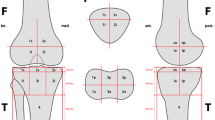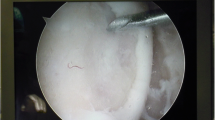Abstract
Purpose
The aim of this study is to follow morphological imaging characteristics and osteointegration of TruFit® bone graft substitute (BGS) plugs in cases of chondral and osteochondral defects of the articular surface of the knee joint, using high-quality cartilage-sensitive 3-T magnetic resonance imaging (MRI), linked to clinical outcomes.
Methods
The MRI was used to assess osteointegration and biological evolution of the TruFit® BGS plugs in cases with minimum 5-year follow-up: The TruFit® plug was used in 46 patients for a total of 47 cases with mean age of 57.89 (range 32–80). In this study, we reviewed only the cases with minimum follow-up of 5 years: 5 patients with mean age 64.4 years (minimum 38, maximum 80). The mean follow-up was 71 months (range 63–77). Patients were evaluated clinically, with Lysholm Knee Scoring Scale and MOCART Scale.
Results
3-T MRI, which is preferable to 1.5 T for the better signal-to-noise ratio, contrast and the ability to acquire morphological images at higher spatial resolution, shows a satisfactory integration of bone scaffolds in studied cases for more than 5 years and a satisfactory restoration of the articular cartilage, with the exception of a case of which we still have to consider the factors age, type of lesion and the relationship between the plugs implanted.
Conclusion
Clinical and radiological results significantly improve in a longer follow-up time.




Similar content being viewed by others
References
Siclari A, Mascaro G, Gentili C, Cancedda R, Boux E (2012) A cell-free scaffold-based cartilage repair provides improved function hyaline-like repair at one year. Clin Orthop Relat Res 470:910–919
Kirk JT, Cossey JA (2011) Techniques for cartilage repair in chondral and osteochondral defects of the knee. Acta Orthop Belg 77:152–159
Khan IM, Gilbert SJ, Singhrao SK, Duance VC, Archer CW (2008) Cartilage integration: evaluation of the reasons for failure of integration during cartilage repair. A review. Eur Cells Mater 16:26–39
Dell’Osso et al (2015) Up-to-date review and cases report on chondral defects of knee treated by ACI technique: clinical-instrumental and histological results. Surg Technol Int 26:317–323
Melton JTK, Wilson AJ, Chapman- Sheath P, Cossey AJ (2010) TruFit CB bone plug: chondral repair, scaffold design, surgical technique and early experiences. Expert Rev Med Devices 7:333–341
Dhollander AAM, Liekens K, Almqvist KF, Verdonk R, Lembrecht S, Elewaut D, Verbruggen G, Verdonk PCM (2012) A pilot study of the use of an osteochondral scaffold plug for cartilage repair in the knee and how to deal with early clinical failures. Arthrosc J Arthrosc Relat Surg 28:225–233
Carmont MR, Carey-Smith R, Saithna A, Dhillon M, Thompson P, Spalding T (2009) Case report: delayed incorporation of a TruFit plug: perseverance is recommended. Arthrosc J Arthrosc Relat Surg 25:810–814
Barber FA, Dockery WD (2011) Computed tomography scan assessment of synthetic multiphase polymer scaffolds used for osteochondral defect repair. Arthrosc J Arthrosc Relat Surg 27:60–64
Gomoll AH, Madry H, Knutsen G, Van Dijk N, Seil R, Brittberg M, Kon E (2010) The subchondral bone in articular cartilage repair: current problems in the surgical management. Knee Surg Sports Traumatol Arthrosc 18:434–447
Shapiro L, Steroswiecki E, Gold G (2010) Magnetic resonance imaging of the knee: optimizing 3 Tesla imaging. Semin Roentgenol 45(4):238–249
Workie DW, Dardiinski BJ (2005) Quantifing dynamic contrast-enhanced MRI of the knee in children with juvenile rheumatoid arthritis using an arterial input function (AIF) extracted from popliteal artery enhancement, and the effect of the choice of the AIF on the kinetic parameters. Magn Reson Med 54(3):560–568
Marlovits S, Striessnig G, Resinger CT, Aldrian SM, Vecsei V, Imhof H, Trattnig S (2004) Definition of pertinent parameters for the evaluation of articular cartilage repair tissue with high-resolution magnetic resonance imaging. Eur J Radiol 52:310–319
Bedi A, Foo LF, Williams RJ, Potter HG III (2010) The maturation of synthetic scaffolds for osteochondral donor sites of the knee an MRI and T2-mapping analysis. Cartilage 1(1):20–28
Dell'Osso G, Bottai V, Bugelli G, Manisco T, Cazzella N, Celli F, Guido G, Giannotti S (2016) The biphasic bioresorbable scaffold (TruFit(®)) in the osteochondral knee lesions: long-term clinical and MRI assessment in 30 patients. Musculoskelet Surg 100(2):93–96
Author information
Authors and Affiliations
Corresponding author
Ethics declarations
Conflict of interest
The authors declare that they have no conflict of interest. There has been no financial support or industry affiliations of all those involved in this project.
Rights and permissions
About this article
Cite this article
Bugelli, G., Ascione, F., Dell’Osso, G. et al. Biphasic bioresorbable scaffold (TruFit®) in knee osteochondral defects: 3-T MRI evaluation of osteointegration in patients with a 5-year minimum follow-up. Musculoskelet Surg 102, 191–199 (2018). https://doi.org/10.1007/s12306-017-0522-8
Received:
Accepted:
Published:
Issue Date:
DOI: https://doi.org/10.1007/s12306-017-0522-8




